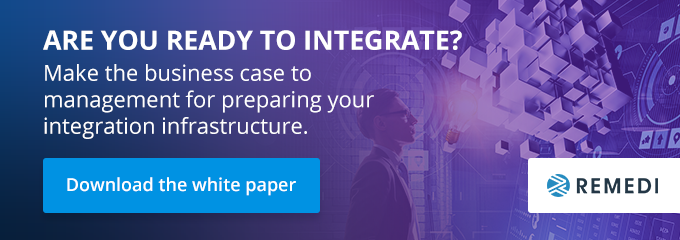Key Takeaways
- Real-Time Data Synchronization: Achieve real-time data flow and improve accuracy in inventory management and order processing by integrating cloud-based ERP and EDI systems.
- Identify the Right Integration Tools: Focus on scalability, security, and compatibility when choosing integration tools.
- Data Security Done Right: Implement robust security measures including end-to-end encryption and data anonymization to prevent unauthorized and comply with regulatory standards.

Cloud-based ERP (Enterprise Resource Planning) offers the same capabilities of ERP software but delivered through the cloud. Businesses manage many processes including finances, operations, supply chain management, and manufacturing via ERP systems.
Electronic Data Interchange (EDI) encompasses the digital exchange of business documents between trading partners. With EDI, electronic submissions replace paper-based processes.
Integration strategies are crucial to maximize efficiency and effectiveness. Integration enables seamless data flow allowing EDI transactions to be processed automatically within the ERP system. It also allows the ERP system data to reflect the most accurate inventory levels, order status, and relevant financial information based on real-time EDI transactions.
Assessing Your Integration Needs
A successful implementation with cloud ERP integration depends on first identifying your organization’s specific business requirements for ERP and EDI integration. As a first step, it’s important to thoroughly assess your organization’s existing business processes. It starts with knowing how various departments interact with each other and identify areas where issues have occurred in the past particularly in regard to errors and delays. At this phase, you’ll want to document workflows and gather input from stakeholders to understand what they need.
It’s also necessary to get a good idea on how data flows between systems. As part of this process, you’ll need to identify data sources in both your ERP and EDI systems and any external sources including customers and suppliers. Understanding data flow helps to ensure your organization meets regulatory requirements.
Choosing the Right Integration Tools
There are a variety of different tools and technologies available for integrating ERP and EDI in the cloud. Middleware and integration platforms are at the core of this integration in EDI cloud solutions with middleware solutions acting as a bridge between cloud ERP and EDI systems.

APIs (Application Programming Interfaces) play a crucial role in integrating ERP and EDI systems by enabling real-time data exchange. Another category to consider is data transformation and mapping tools. One example is EDI translation software that translates EDI formats to and from ERP system formats.
When choosing tools for EDI integration strategies , consider factors such as scalability, security, and compatibility. You’ll need to make sure that whatever integration tool you choose is able to handle an increase in data volumes and transaction loads. Cloud-based solutions have the advantage here. When evaluating an integration tool’s security features, you’ll want to look for data encryption, support for authentication and access control mechanisms, and secure protocols.
Cloud Integration Architecture Design
Designing a robust integration architecture for cloud-based systems requires several key components including middleware, an API Gateway, and a focus on data integration. Middleware connects ERP and EDI systems and facilitates data transformation, routing, and workflows. The API Gateway serves as a managed entry point for all APIs.
In order to design an architecture that supports seamless data exchange and real-time processing, define integration requirements at the outset. Analyze your business processes and data flows and know how your systems interact. Design with scalability in mind, distributing workloads appropriately.
Implementation Best Practices
Implementing ERP and EDI integration solutions involves some best practices to ensure smooth integration. Involve stakeholders throughout the process to ensure alignment with business requirements. A comprehensive approach to testing is crucial including unit testing, integration testing, and end-to-end testing. After testing is complete, reduce risks with a phase roll-out. Implement continuous monitoring afterward to confirm systems stability and performance.
Managing Data Security and Compliance
Integrating cloud-based ERP and EDI introduces specific security challenges related to data protection, authentication and access control, and compliance. The challenge with data protection is the need to ensure data integrity and confidentiality is maintained during data transmission and when data is stored across cloud environments in EDI cloud solutions. Managing secure access to integrated systems, particularly ones that have a steady stream of API calls, is challenging but so essential for preventing unauthorized access and data breaches.

There are multiple strategies to ensure data security and compliance with relevant regulations. Ended-to-end encryption, both for data in transit and while at rest, prevents unauthorized access. In the event of authorized access, masking or anonymizing sensitive data to reduce the risk of exposed data.
Troubleshooting Common Integration Issues
Here are some common challenges you could encounter during ERP and EDI integration projects:
- Mapping errors: These can result from inconsistent data formats between ERP and EDI systems. To mitigate, conduct thorough data mapping and data validation tests early in the project’s lifecycle.
- Integration complexity: Bottlenecks can occur when integrating several systems, each with its own protocols. Ensure you pick middleware platforms that offer robust support for multiple protocols.
- Scalability and performance issues: Performance or scalability limitations can result from suboptimal architecture or inefficient data handling. Make sure to perform load testing by simulating various conditions.
Case Studies and Success Stories
Procter & Gamble (P&G) integrated SAP ERP with EDI for supply chain management and procurement. Their ability to adhere to EDI standards for consistent data exchange and effective collaboration with their suppliers and distributors helped contribute to the success of this initiative.
Adidas manages global manufacturing and distribution by using cloud-based ERP systems integrated with EDI. The company’s ability to adapt to changing market demands and a customer centric approach helped fuel their success with implementing integration strategies.
Conclusion
In today’s digital age, a strategic approach to integrating cloud-based ERP and EDI systems is important for organizations to remain competitive. The benefits of a successful integration between these two systems include real-time data synchronization and improved decision-making capabilities. As part of your organization’s digital transformation, adopt thoughtful and well-planned integration strategies to achieve your business objectives.



